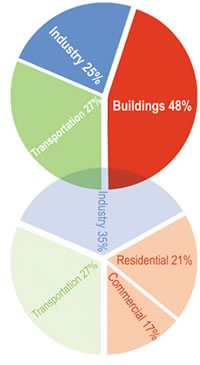

2/2006
Renowned energy architect Ed Mazria spells it out clearly

by Russell Boniface
Associate Editor
In the film The Day After Tomorrow, a scientist tries to figure out a way to save the world from abrupt global warming. Unfortunately, the end result is worldwide catastrophe and disaster, including hurricanes, tornadoes, tidal waves, floods, and the beginning of the next Ice Age.
The good news, however, is it’s only a movie. But, can this really happen?
 Fiction meets fact
Fiction meets fact
Although the film is fantastical, it did raise public awareness of the
destructive trend toward global warming, something real-life scientists
and architects have known about for quite some time and have been addressing.
Global warming, we know, is caused—in part, at least—by
a manmade blanket of greenhouse gases, mainly carbon dioxide, caused
by the burning over the last hundred or so years of millions of year’s
accretion of fossil fuel. These gases surround the Earth and trap in
heat. If allowed to intensify over the coming years, it could seriously
threaten our planet.
“We have to get a handle on reducing emissions in 10 years, otherwise we will probably reach a tipping point,” says architect Edward Mazria, AIA, senior principal at Mazria Inc. Odems Dzurec in Santa Fe. He is the well-known author of the architecture classic, The Passive Solar Energy Book, as well as senior analyst for the Southwest Climate Council and adjunct professor at the University of New Mexico. He speaks nationally and internationally on the subject of climate change and architecture. Mazria initiated “Architecture 2030,” a Web site launched January 5 to provide information and innovative solutions for addressing and reversing the effects of global climate change.
“About two or three years ago, an issue of Metropolis came out, and the cover said ‘Architects Pollute,’” explains Mazria. “A major story in the magazine was about the building sector and its responsibility for climate change. We took a look at the building sector and discovered that it was responsible for about half of all global greenhouse gas emissions annually. So, when you start looking at solutions to global warming and greenhouse gas emissions, you have to look at the building sector, because that’s the sector that is increasing most rapidly.”
The goal, he says, is zero emissions for building operations by 2030. “If we don’t meet that target globally, we really don’t have a chance to stem this crisis.” The AIA has responded by starting an initiative to reverse the environmental impact of greenhouse gas emissions by the U.S. building sector. The AIA, adopting many of the actions called for by Architecture 2030, set a goal of reducing the fossil fuel consumption of buildings by 50 percent in four years, with additional 10-percent reductions every five years thereafter.
 Keeping an eye on the Earth’s equilibrium
Keeping an eye on the Earth’s equilibrium
Mazria explains that global warming due to fossil fuel burning is the
Earth’s way to maintain equilibrium with space. “We have
inputs coming in, such as solar radiation. Then, we have this blanket
of greenhouse gases surrounding the Earth that we keep intensifying
because of burning fossil fuel. That incoming radiation gets trapped
by the blanket, so, for the Earth to maintain equilibrium, its temperature
just goes up.” Mazria maintains that new-building design can
be a way to keep the global thermostat from rising. “You can
get a 50 to 80 percent reduction in fossil fuel consumption just through
building design. The largest reduction has to come through building,
because that is the most cost-effective way to do it.”
The “Architecture 2030” Web site includes a variety of resources to help architects and government officials plan and design for a carbon-neutral future. In addition to examples of sustainable designs, there are many breakdowns, often using charts and graphs, that illustrate some staggering statistics as to how the building sector is above the industry and transportation sectors in fossil fuel emissions; the impact of the average American’s production of carbon dioxide in a single year (of 22 tons); why 10 billion tons of carbon dioxide ends up in the atmosphere; and the current impact of emissions on water, plant and animal life, weather, health, the Arctic, and the sea level.
Reducing fossil fuels through building design
The Web site comes at a critical time as the U.S. and China, at December’s
United Nation’s climate change conference in Montreal, refused
to agree to mandatory steps to curtail their greenhouse gas emissions.
The good news is that, in addition to the AIA, many cities, states, organizations,
and design professionals are accepting the challenge to tackle climate
change through building design.
With about 5 billion square feet of new construction and 5 billion square feet of renovation taking place in the U.S. each year, the potential for reducing energy consumption and carbon dioxide emissions is enormous, according to Mazria in his article, “The Building You're in Fuels Global Warming Architects,” published by the Los Angeles Times. Mazria states that buildings can be designed to require less than half the energy of today’s average U.S. building, with no additional cost, through proper siting, building form, material selection, glass properties, and location. He adds that technology such as photovoltaics; solar hot water; wind power; daylighting strategies; and natural heating, cooling, and ventilation will also play a role. Mazria adds that to achieve such a reduction, government at all levels must pass laws that all major governmental building-renovation and new-building projects be designed to use half the energy now typically consumed. When these standards are in widespread use, building codes for all housing developments and commercial, institutional, and multifamily buildings can be changed to the standard in place for government buildings.
But Mazria stresses time is running out. “If we don’t address the problem by 2050, we will reach global temperatures that we haven’t seen in over 450,000 years, maybe 3 million years, so the entire planet may change into a climate system that it hasn’t had in a very long time. When we study what the planet was like at those temperatures (at those time periods), we see some very disturbing situations.”
 Rising sea level a concern
Rising sea level a concern
One of the biggest things that Mazria and scientists have discovered
is the potential for sea-level rise, especially on the East Coast and
the Gulf Coast. “What scientists are telling us is that a one-meter
rise in sea level is expected by 2100. That’s just three feet.
We know that by 2050 we will be in a climate pattern that, in order
for the Earth to maintain equilibrium, will be similar to that of 120,000
years ago, the last interglacial period. At that time, the temperature
was between 1 and 2 degrees Centigrade above pre-industrial levels.
That is where we are headed, about a two degrees Centigrade rise by
2100. It took the Greenland ice shield 120 years to melt—a very
short time—at that same climate. So if 2100 is a similar climate
to when the Greenland ice shield melted, the sea level will rise by
6 meters, or 20 feet.”
 Mazria
points out that we must limit the rise in global temperature to less
than two degrees Centigrade above pre-industrial levels to avoid disastrous
impacts. “If the temperature rise goes to three degrees
Centigrade by 2070, sea level could rise 20-25 meters, almost 80 feet
above where it is now.” says Mazria. “We have to go back
3 million years to find a similar climate. All of a sudden, NASA is saying
this could happen if the sheets melt in the next few hundred years. That
is pretty traumatic.” The Architecture 2030 Web site has charts
that show the impact of both a one-meter rise and a six-meter rise the
on the East Coast and Gulf Coast.
Mazria
points out that we must limit the rise in global temperature to less
than two degrees Centigrade above pre-industrial levels to avoid disastrous
impacts. “If the temperature rise goes to three degrees
Centigrade by 2070, sea level could rise 20-25 meters, almost 80 feet
above where it is now.” says Mazria. “We have to go back
3 million years to find a similar climate. All of a sudden, NASA is saying
this could happen if the sheets melt in the next few hundred years. That
is pretty traumatic.” The Architecture 2030 Web site has charts
that show the impact of both a one-meter rise and a six-meter rise the
on the East Coast and Gulf Coast.
 In his open letter “Beware: The Carriage Turns into a Pumpkin
at 2° C!,” featured on the Architecture 2030 Web site, Mazria
explains that at 2 degrees Centigrade, the Greenland ice sheet will begin
to melt; snow pack will decrease, threatening urban water supplies; millions
of people will be displaced from their homes; food production will decline;
rivers will become too warm for trout and salmon; weather will become
more extreme; the world’s coral reefs—home to 25 percent
of all marine species—will be destroyed; and a quarter of all plant
and animal species on Earth will become extinct.
In his open letter “Beware: The Carriage Turns into a Pumpkin
at 2° C!,” featured on the Architecture 2030 Web site, Mazria
explains that at 2 degrees Centigrade, the Greenland ice sheet will begin
to melt; snow pack will decrease, threatening urban water supplies; millions
of people will be displaced from their homes; food production will decline;
rivers will become too warm for trout and salmon; weather will become
more extreme; the world’s coral reefs—home to 25 percent
of all marine species—will be destroyed; and a quarter of all plant
and animal species on Earth will become extinct.
 Architects can effect fossil fuel reduction
Architects can effect fossil fuel reduction
Mazria recommends on “Architecture 2030” that all new buildings,
developments, and major renovation projects be designed to use half the
fossil fuel energy they would typically consume. Then, the fossil fuel
reduction standard for all new buildings should be increased to 60 percent
in 2010, 70 percent in 2015, 80 percent in 2020, 90 percent in 2025,
and carbon-neutral by 2030.
To support this effort, he suggests the establishment of a mandatory, full-year, studio-based program in architecture schools to promote problem-solving ideas based on understanding the relationship between nature and design. He also states that major reductions in the emissions can result from using low-embodied energy materials, technologies, and processes. Mazria encourages that architects, designers, and planners accept the challenge and responsibility of carbon-neutral architecture and building construction.
“What we are finding is that the conversation within the architecture community is beginning to change—and it must change,” stresses Mazria. “Right now the conversation in the global architecture community and the public media is dominated by a small handful of talented architects. If we are going to attack global warming, the dialogue has to change from a handful of architects to the entire architecture community.”
Copyright 2006 The American Institute of Architects.
All rights reserved. Home Page ![]()
![]()
The “Architecture 2030” Web site will report on the activities and progress in the building sector around the globe and critical information will be updated regularly.
The series of maps shown in the article indicate the amounts of coastland underwater should sea level rise one meter and three meters.
Ed Mazria will be a keynote speaker at the AIA Committee on Design and
the Committee on the Environment “The Architecture of Sustainability” conference,
May 4–7, at the National Conservation Training Center in Shepherdstown,
W.Va. For the full conference agenda or to register online, visit the
COD Web site. ![]()
![]()